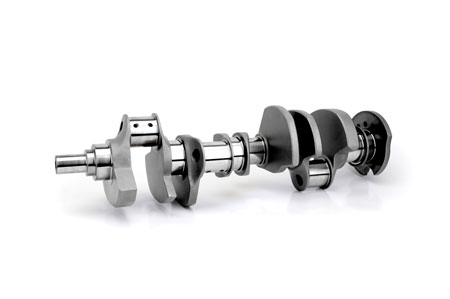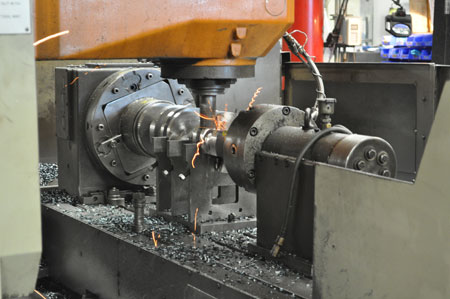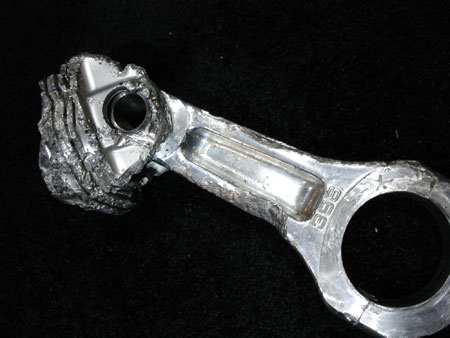As an engine builder, you get to decide what parts go into the engines you build. If you’re rebuilding a stock engine to stock specifications, you’re probably going to use a reconditioned stock crankshaft and connecting rods to keep costs down. There’s no reason to upgrade these parts because they should be adequate for the loads they are designed to handle.
But if you’re building a performance engine that’s going to develop significantly more power than stock (say 150 to 200 hp or more), you’ll have to upgrade to a stronger forged steel crank and rods. Push a stock crank and rods too far and eventually something will fail.
Aftermarket suppliers have a wide variety of forged cranks and performance rods to fit almost anything that is commonly built today. Everybody has cranks and rods in various strokes and lengths that will fit most SB/BB Chevy, Ford and Chrysler engines, plus many Oldsmobile, Pontiac and vintage Ford engines, and even a lot of sport compact engines (Honda, Mitsubishi and others). But what do you do if nobody has an off-the-shelf crank or set of rods that will work in an engine a customer wants you to build or rebuild? Your only option may be to have the parts custom made.
Billet cranks have been around a long time and are used in everything from Top Fuel dragsters and NASCAR to diesel-powered sled pullers. Billet cranks are CNC machined from a solid bar of steel such as EN30, 4330M or other high-grade alloy. Unlike a forged crank that has to be heated, stamped and twisted into shape in a high-pressure forging press, a custom CNC billet crank is machined at room temperature to final dimensions in a CNC machine. There’s no squeezing, bending or twisting of the metal involved, just a LOT of milling and machining to sculpt the bar stock into a finished crankshaft.
How Billet Cranks Differ From Forged Cranks
The main advantage of creating a crankshaft by CNC machining a solid bar of steel is that it doesn’t disturb or distort the grain structure of the metal. It cuts across the grain structure. By comparison, a forging really moves the metal around quite a bit. Forcing hot metal to flow into the cavities of a forging press under great pressure compresses and deforms the grain structure of the steel.
The compressive forces experienced by the metal during the forging process increase strength compared to a casting. But it also creates and concentrates internal stresses in areas that undergo the most deformation, which is typically the critical overlap areas between the main and rod journals. These residual stresses have to be relieved by a subsequent heat treatment process to relax the metal so the stresses can dissipate.
Those who make custom CNC billet cranks say billet cranks are the best money can buy. They are expensive, costing anywhere from 3 to 20 times as much as an off-the-shelf cast or forged crank. They cost so much for a couple of reasons. One is that a custom billet crank requires engineering development time if you want something that hasn’t been done before or requires modifying an existing design. Changing the stroke may not seem like a big deal on a crank that’s already been developed and programmed, but changing the stroke changes the size and positioning of the counterweights and the location of the oil holes which requires redoing the CNC programming.
Even if a billet crank you want has already been developed and programmed, CNC machining a solid bar of steel into a finished crank still takes a LOT of milling and cutting – and a lot of handling. One crank supplier we interviewed who makes CNC billet cranks said a typical high-end racing crank may be in and out of their CNC machine 18 to 20 times during the manufacturing process so various measurements, checks and machining processes can be verified and completed. All that handling adds time and cost.
The crank supplier also has to earn a return on his investment in his CNC machine and all of the fancy tooling it takes to machine a crankshaft. High-end CNC machines can easily cost upwards of $100,000 to $200,000 or more, and the tooling is expensive to replace when it wears out or breaks. It also takes a highly skilled operator to program, operate and babysit the equipment.
Of course, forgings are not cheap
either when you factor in the cost of the forging dies. But the same set of dies can be used to whack out thousands of rough forgings, lowering the overall cost of each part – especially if it is made offshore using cheap labor. It also takes much less machining to finish a rough forging than to CNC a complete crank out of bar stock. So that’s why a CNC crank for a SB Chevy might set you back $2,800 or more versus $600 to $800 for an entry-level forged crank.
Custom Billet Crankshafts
What’s actually involved in getting a custom billet crankshaft made? It starts with a phone call to the crankshaft supplier. The first thing they’ll want to know is what type of engine the crank is going into, how that engine will be used and how much power it will make. Are you doing an antique restoration project with relatively low power output and light use, or are you building a blown nitro burning all out racing engine? A crank that has to handle 3,000 to 5,000-plus horsepower will obviously have different dimensional and metallurgical requirements than a crank that may only have more moderate loads.
The crank supplier will need all of the physical dimensions such as bore spacing, stroke length, rod and main journal diameters and widths, rod length, snout and end configuration, etc. They will also need an estimated bobweight for the rods, pistons and rings so the counterweights can be sized and positioned accordingly for proper engine balance with minimum mass. Do you want the counterweights profiled or knife-edged to reduce windage? Do you want extra polishing on the journals or a special finish on the crankshaft?
Do you want the rod throws rifle drilled to reduce weight? How do you want the oil holes drilled and configured? Where do you want the keyway positioned on the nose of the crank? Once all of these details have been ironed out and written down on a work order form, the supplier can begin the production process that will bring your custom CNC billet crank to completion.
The time it takes to make a custom billet crank can vary quite a bit depending on what you want. The more development work the crank requires, the more time it adds to the manufacturing process. According to several crank suppliers we spoke with, typical lead times, start to finish, range from 8 weeks up to 12 weeks. The busier the supplier is, the longer it will take to get your crank. One supplier said they may have anywhere from 200 to 500 cranks in process in their shop, depending on the time of year.
Finishing Steps
One of the final steps in the manufacturing process with both CNC and forged cranks is usually nitriding, which adds a hard surface layer to the crank to improve journal life and fatigue resistance. The trick is to get a layer that is deep enough to provide the desired benefits without being too thick and making the crank too brittle.
One supplier said they aim for a relatively thin layer that peaks at about .003? in depth and tapers off from there as you go deeper into the metal. Nitriding diffuses atoms of nitrogen into the surface of the steel to harden it. Various areas of the crank may be masked off (such as the radius areas of the journals) because excessive hardness here increases the risk of cracking.
Cracks often begin in highly stressed areas like the journal fillets, near oil holes, or near the snout where there are high loads from the drive belts (especially a blower belt). Most performance cranks are machined with a larger radius in the journal fillets (which may require using chamfered rod and main bearings). Cranks with oversized snouts are also available for blower applications or other applications that place unusually heavy belt loads on the crank.
Shot peening the surface of the crank also helps improve strength and reliability by increasing surface hardness and eliminating stress risers that might form cracks. Cryogenic treatment (freezing to 300 degrees below zero in liquid nitrogen) is also said to relieve residual stress and improve durability.
Polishing the journals to make them as smooth as possible is pretty much standard, but polishing the entire surface of the crankshaft to create a smooth chrome-like finish can also reduce surface stresses as well as windage and oil shedding. Some crank suppliers who offer a special finish on their cranks claim it results in a 1 to 4 percent gain in usable horsepower at the flywheel.
Stroker Cranks
Stroker cranks are extremely popular these days as a way to add displacement, torque and power, but there are some tradeoffs. So before you go nuts with stroking an engine with either a forged or CNC crank, consider the following. Stroker cranks are good for low-end torque and off-the-line throttle response, but are not as good for high rpm power.
Also, the longer the stroke, the more counterweight is needed to offset the greater motion of the pistons and rods. This, in turn, may require using expensive heavy metal to balance the crank. With some long stroke cranks, it may not be possible to achieve internal balance by adding metal to the counterweights. The engine may also have to be externally balanced.
With internally balanced engines, the counterweights themselves handle the job of offsetting the reciprocating mass of the pistons and rods. In externally balanced engines, additional counterweights on the flywheel and/or harmonic damper help the crank maintain balance. Some engines (like Chevy LS) use a combination of internal and external balancing to control vibrations.
Connecting Rods
The rods you choose obviously have to be matched to the crank and the stroke of the engine you are building as well as the engine’s power output and application. Stock rods are usually adequate for stock engines, but the power metal rods in many late-model engines need to be upgraded when serious changes in engine power or rpm are made.
If a rod is going to fail, it will most likely do so at high rpm when it is being pulled apart at TDC on the exhaust stroke, rather than from compression loads during the power stroke. Consequently, you have to use stronger rods in high-rpm engines.
You also want rods that are as light as possible in high revving engines to reduce reciprocating weight (which also means the counterweights on the crank can be smaller and lighter). The same goes for lighter pistons. On the other hand, if you are building a low-rpm high-torque motor, reciprocating weight is less critical.
The type of rod (I-beam or H-beam) is less important than the rated strength of the rod. H-beam rods are typically recommended for higher-revving higher-output engines, but there are many excellent I-beam rods that will work just as well in many of the same applications.
As with billet crankshafts, rods can be CNC machined from billet steel or forgings to achieve almost any desired dimension or result. Computer programs that predict the stresses on the rod are typically used to develop new rod designs that maximize strength while minimizing weight. This allows manufacturers to offer a wider variety of custom rods in terms of length and design. Such rods can usually be made-to-order fairly quickly (a week or two lead time), which is why some rod suppliers say that most of the rods they are selling today are custom order rather than off-the-shelf products.
Rod length is another factor that has to be considered. Given the height dimensions of the block and how much stroke is in the crank, you have some wiggle room to play around with rod length. Stroker cranks require shorter rods to maintain the same deck height of the piston at TDC, but you can maximize rod length if you use pistons that have a higher wrist pin location.
Why do this? A longer rod allows the piston to dwell longer at TDC before it starts back down on the power stroke. This allows pressure to build longer in the combustion chamber, producing a broader, flatter torque curve than the same engine with shorter rods. For some applications, this is a desirable characteristic to build into the engine. For others, it may not matter.
Most engines today have a rod ratio (the length of the rod center-to-center divided by the stroke of the crankshaft) of 1.5 to 2.1. Most performance engine builders say a rod ratio in 1.57 to 1.67 range works best as higher ratios can make the torque curve peak too sharply. Lower rod ratios are typically found in lower rpm high torque motors, such as a stroked 383 Chevy small block.
Wrist pin offset is also important. On many rods, the location of the wrist pin is slightly offset to reduce the stress on the piston pin and small end of the rod when the piston reaches TDC and changes direction. An offset pin location reduces the rocking motion of the piston as it passes TDC to reduce piston slap and noise.
Some racers are running rods that have no wrist pin bushing, so if you are ordering a set of custom rods you might want to look at this possibility. Eliminating the bushing leaves more metal for a thicker and stronger small end of the rod, but it also requires a hard wear-resistant coating on the pin so it will work with the piston.


 racing. a custom billet crank can be made in about 8 weeks.”/>
racing. a custom billet crank can be made in about 8 weeks.”/>













